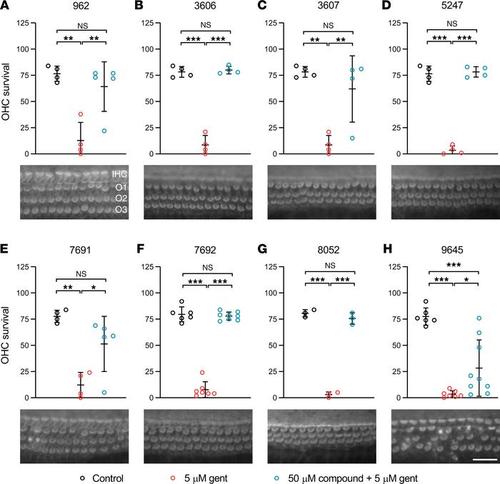Fig. 2
- ID
- ZDB-FIG-210504-2
- Publication
- Kenyon et al., 2021 - Identification of a novel series of hair-cell MET channel blockers that protect against aminoglycoside-induced ototoxicity
- Other Figures
- All Figure Page
- Back to All Figure Page
|
Compounds protecting mammalian cochlear hair cells from gentamicin without visible damage to the hair bundles. (A–H) Graphs showing the numbers of surviving OHCs in a region of interest (ROIs) 20% from the basal end of the cochlea in cultures exposed to low-serum medium (LSM), LSM with 5 μM gentamicin, or LSM with 5 μM gentamicin and 50 μM of (A) UoS-962, (B) UoS-3606, (C) UoS-3607, (D) UoS-5247, (E) UoS-7691, (F) UoS-7692, (G) UoS-8052, and (H) UoS-9645. DMSO at 0.5% in all conditions. Each compound was tested on the following number of independent occasions alongside a control and 5 μM gentamicin condition: UoS-962 (n = 4), UoS-3606 (n = 4), UoS-3607 (n = 4), UoS-5247 (n = 4), UoS-7691 (n = 4), UoS-7692 (n = 6), UoS-8052 (n = 3), and UoS-9645 (n = 6); additionally, in some instances compounds were tested twice within 1 experiment. One-way ANOVA with Tukey’s multiple-comparison test revealed all compounds were protective, with numbers of OHCs in the presence of test compounds and gentamicin significantly different from cultures exposed to gentamicin alone. Numbers of OHCs in cultures incubated with gentamicin and UoS-9645 were significantly lower than those in cultures exposed to LSM alone. Symbols represent individual replicates. Each symbol represents numbers of OHCs in a mid-basal ROI from 1 culture. Error bars show standard deviation of the mean (SDM). *P < 0.05; **P < 0.01; ***P < 0.001; NS, no significant difference. Representative images of the ROI from cultures exposed to LSM with 5 μM gentamicin and 50 μM of each compound show the protection offered, with phalloidin-stained hair bundles clearly visible. Scale bar: 25 μm. |

